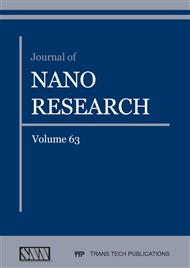[1]
J.J. Ramsden , D.M. Allen , D.J. Stephenson, J.R. Alcock , G.N. Peggs, G. Fuller, G. Goch, The Design and Manufacture of Biomedical Surfaces, CIRP Annals-Manufacturing Technology. 56 (2007) 687-711.
DOI: 10.1016/j.cirp.2007.10.001
Google Scholar
[2]
S.C. Jayswal, V.K. Jain, P.M. Dixit, Modeling and simulation of magnetic abrasive finishing process, International Journal of Advanced Manufacturing Technology. 26 (2005) 477–490.
DOI: 10.1007/s00170-004-2180-x
Google Scholar
[3]
Sunil Jha , V.K. Jain , Design and Development of Magneto rheological Abrasive Flow Finishing Process, International Journal of Machine tool and Manufacture. 44 (2004) 1019-1029.
DOI: 10.1016/j.ijmachtools.2004.03.007
Google Scholar
[4]
T.Shinmura , K.Takazawa, E. Hatano , Study on magnetic abrasive process- application to plane finishing, Bulletin of the Japan Society of Precision Engineering .19 (4) (1985) 289–291.
Google Scholar
[5]
T.Shinmura, K.Takazawa , E.Hatano , M.Matsunaga ,Study on Magnetic Abrasive Finishing, Annals of the CIRP. 39 (1990) 325–328.
DOI: 10.1016/s0007-8506(07)61064-6
Google Scholar
[6]
Yamaguchi Hitomi , Shinmura Takeo, Study of an internal magnetic abrasive finishing using a pole rotation system discussion of the characteristic abrasive behavior, Journal of international societies for precision engineering and nanotechnology. 24 (2000) 237-244.
DOI: 10.1016/s0141-6359(00)00037-4
Google Scholar
[7]
Dhirendra K Singh, V.K. Jain , Experimental investigations into forces acting during a magnetic abrasive finishing process, International Journal of Advanced Manufacturing Technology. 30 (2006) 652-662.
DOI: 10.1007/s00170-005-0118-6
Google Scholar
[8]
V.K. Jain, Prashant Kumar, P.K. Behera , S.C .Jayswal ,Effect of working gap and circumferential speed on the performance of magnetic abrasive finishing process, Wear. 250 (2001) 384-390.
DOI: 10.1016/s0043-1648(01)00642-1
Google Scholar
[9]
Dhirendra K Singh , V.K. Jain , V. Raghuram , Parametric study of Magnetic Abrasive finishing process, Journal of materials processing technology. 149 (2004) 22-29.
DOI: 10.1016/j.jmatprotec.2003.10.030
Google Scholar
[10]
T.Mori , K.Hirota , Y.Kawashima ,Clarification of magnetic abrasive finishing mechanism, Journal of Materials Processing Technology. 143-144 (2003) 682-686.
DOI: 10.1016/s0924-0136(03)00410-2
Google Scholar
[11]
G.Z. Kremen , E.A. Elsayed , V.I. Rafalovich , Mechanism of material removal in the magnetic abrasive process and the accuracy of machining, International Journal of Production Research. 34(1996) 2629-2638.
DOI: 10.1080/00207549608905048
Google Scholar
[12]
Lieh Dai Yang, Ching Tien, Han Ming Chow., Optimization in MAF operations using Taguchi parameter design for AISI304 stainless steel, International Journal of Advanced Manufacturing Technology. 42 (2009) 595-605.
DOI: 10.1007/s00170-008-1612-4
Google Scholar
[13]
Kim, Jeong-Du, Choi,Min-Seog , Simulation for the prediction of surface accuracy in Magnetic abrasive machining,Journal of Material Processing technology . 53 (1995) 630-642.
DOI: 10.1016/0924-0136(94)01753-n
Google Scholar
[14]
R.H. Myers , D.C. Montgomery, Response surface methodology process and product optimization using Design of Experiments, John Wiley & Sons, New York, NY,USA,2nd edition,(2002).
Google Scholar
[15]
J.M. Sun, R. Tao, Viscosity of a one-component polarisable fluid, Physical Review E 52 (1) (1995) 813–818.
Google Scholar
[16]
K. Gajalakshmi, N. Senthilkumar, B. Prabhu, Multi-response optimization of dry sliding wear parameters of AA6026 using hybrid grey relational analysis coupled with response surface method, Measurement and control, 52 (5-6) (2019) 540-553.
DOI: 10.1177/0020294019842603
Google Scholar
[17]
S. Ponnuvel, N. Senthilkumar, A study on machinability evaluation of Al-Gr-B4C MMC using response surface methodology –based desirability analysis and artificial neural network technique, International journal of rapid manufacturing, 8 (1-2) (2019) 95-122.
DOI: 10.1504/ijrapidm.2019.097030
Google Scholar
[18]
N. Shanmuga Sundaram, N. Murugan ,Dependence of ultimate tensile strength of friction stir welded AA2024-T6 aluminum alloy on friction stir welding process parameters, Int Sci J Mech. 78(4) (2009) 17-24.
DOI: 10.5755/j01.mech.18.5.2699
Google Scholar
[19]
J.Colligan , J. Paul, Konkol , J. James ,Fisher , R. Pickens Joseph, Friction stir welding demonstrated for combat vehicle construction,Weld J . 82 (3) (2003) 34-40.
Google Scholar
[20]
RE.Rosenweig, Ferro hydrodynamics, New York: Dover; (1985).
Google Scholar
[21]
J.Huang, JQ.Zhang , JN.Liu , Effect of magnetic field on properties of MR fluid, International Journal of Modern Physics B . 19 (2005) 597–601.
Google Scholar
[22]
Derringer, R.Suich , Simultaneous optimization of several response variables, Journal of quality technology. 12 (1980) 214–219.
DOI: 10.1080/00224065.1980.11980968
Google Scholar


